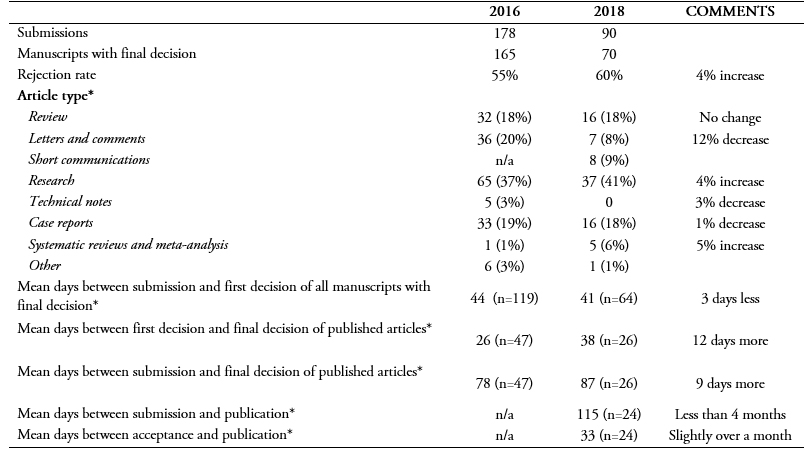Editor’s comment
← vista completaPublished on March 4, 2019 | http://doi.org/10.5867/medwave.2019.02.7587
Getting your paper published fast: Medwave stats before and after introducing author fees
Su trabajo publicado rápidamente: las estadísticas de Medwave antes y después de introducir la política de cobro a autores
In mid-2017, we published an editorial in which we communicated our readership that we would start charging authors a fee for their accepted manuscripts.1 The decision to levy article-processing charges is a harsh decision, and we had postponed it for many years, despite the evident need to generate revenues that could ensure long-term sustainability for the journal. Back then, we relied solely on the sister Medwave companies to buttress the costs of running and publishing a journal, but the economic downturns and market changes left us no other choice. We set up the terms, updated our editorial policies to make it very clear that to continue our open access policy we had to charge, and clinched our teeth waiting for the worst.
As expected, there was an immediate drop in submissions, which did not affect us in the short term—we had a reasonable number of manuscripts still in the pipeline. However, after a few months, in early 2018, submissions dwindled and this affected the number of articles that we published. In the first few months after instituting our new policy, we did not receive any income from editorial processing fees. By March/April of 2018, slowly but surely, we started to receive submissions from authors who a) where well aware of having to pay and b) were willing to pay the charges (we have a small submission fee and a more substantial publication fee).
I will now describe the impact that this policy has had on several journal indicators. I will also provide journal indicators that authors are interested in, but unrelated to this policy.
In Table 1, we can see how 2018 compares to 2016, the last full year in which no author processing charges were applied. The following findings stand out:
- The number of unsolicited submissions fell drastically, from 178 in 2016, to 90 in 2018. You can be sure that we felt this. The good news is that we are still getting a reasonable flow of manuscripts coming in.
- Our rejection rate increased, to 60%, which is pretty much how we stand regardless of article charges. This increase helped dissipate the fear of a conflict of interest creeping in. Charging article fees has not resulted in a greater acceptance rate. We are keeping up our standards.
- The article type has changed compared to 2016, but the difference is not actually "clinically significant," except for the drop in letters and comments which was offset by a slight but significant increase in research articles and systematic reviews.
 Full size
Full size The table also includes indicators on wait times after submission of a manuscript. These indicators are very important to authors in the academic field, who are under pressure from their institutions to publish. Here too, we are pleased to report that our mean numbers are consistently up-to-par, to what the scholarly publishing industry has unofficially set as best practices. More to the point, in Medwave it takes authors on average less than four months from submission to publication, a bit over a month from acceptance to publication, and less than a month and a half between submission and first decision. These periods are in part under our editorial control, but in part also depend upon the author's initiative (e.g., submitting a corrected version of their manuscript promptly, or not). Consequently, overall, these numbers are good.
Many different and fascinating issues are involved in running a journal—publication ethics, scholarly preservation standards, dissemination, publishing in two languages, and so on. In this editor's note, I have touched upon an operational one: the rejection rate and the wait times. We know you want to get your paper out there as soon as possible while safeguarding proper editorial and peer review standards. We are doing our best given our resources to ensure that the service we provide to our authors and readers is the best possible.
Notes
Interests
Vivienne C. Bachelet is the editor-in-chief of Medwave, a self-published journal. In this capacity, she is responsible for both editorial decisions and journal management.

